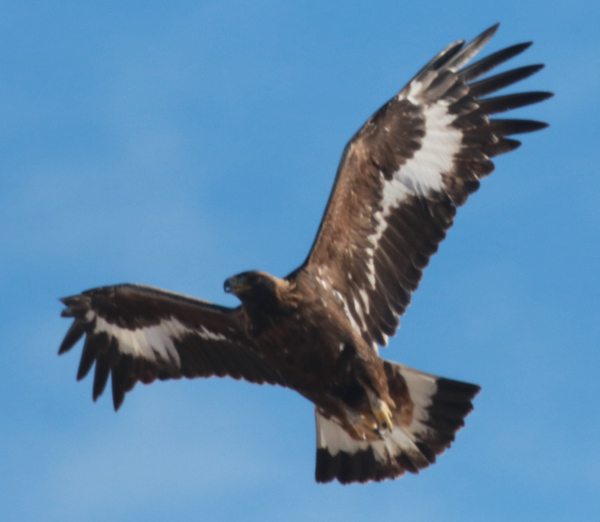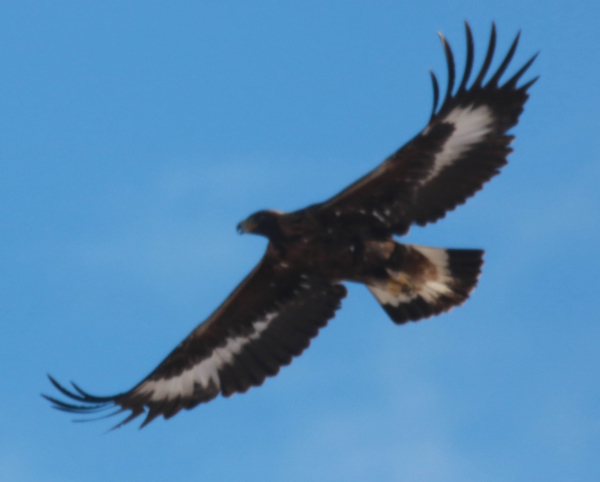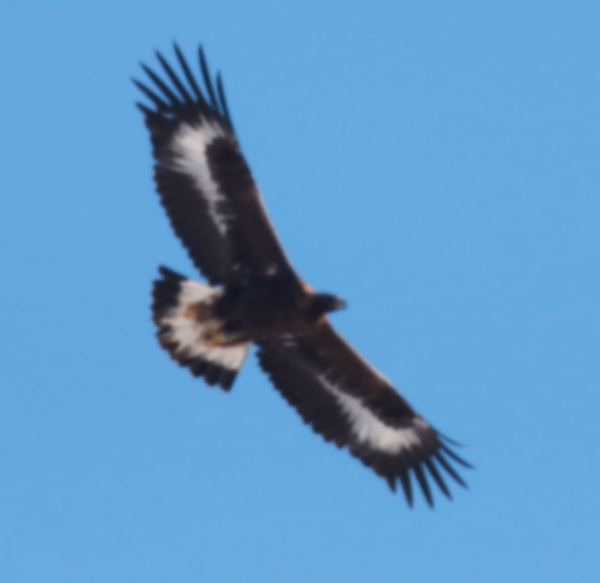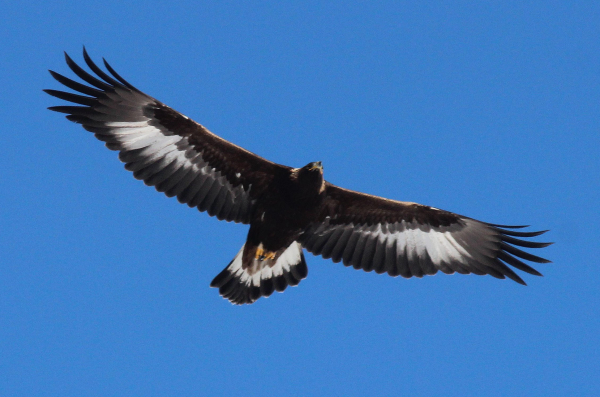
As the young Golden Eagle began to turn, you can see how the sun illuminated some portions of its plumage, but the head is out of the light, and more out of focus than lighted parts of the big raptor.
|
Photographers quickly learn that it’s difficult to get good bird photographs. We also learn it can be hard to judge when a given photo opportunity might yield a good photo, even after we’ve taken the images. That point still has me a bit confounded about a great photo opportunity with a striking young Golden Eagle last month. I spied the giant female from quite a distance away, and watched it flush a pheasant, then another, as it flew low over the edge of a cornfield in central South Dakota. I didn’t realize the beauty of the eagle until I was within camera range and noticed that it had the most expansive white coloration on each wing and its flared tail that I’ve ever seen.
This young eagle’s large size and extensive white markings made it an especially attractive photo subject, and I was lucky enough to intercept it as it turned, flaring when it was close enough to fill most of my photo frame. I took a series of images, and as it repositioned for another sweep of the area for potential prey I was excited to take a number of other photos of the memorable eagle in flight as it came ever-closer – then watched it circle upward until it was far beyond the range of my camera lens. What an exciting and hopefully productive photo episode I thought!
My hopes were quelled when I quickly reviewed the photos on my camera’s rear monitor screen, which revealed the resulting photos were not very sharp. The photos showed blurred edges along the outer feathers and head. I find that any hint of blurring on the miniature images on the camera’s rear monitor screen tend to be even more out of focus on a computer screen when you’re reviewing and editing photos. Darn; but maybe one image or more will be salvageable I hoped with likely hyper-optimism.
After enjoying several hours of birding that included more photo opportunities, I settled in for the evening and began to review the photos I took that day. The photos of the young Golden Eagle proved to be a big disappointment; they only underlined how stunning this big bird was, and how good the photos could/should have been if they had been in sharp focus. So what was the problem?
What didn’t work during this extended photo opportunity?

As the eagle turned northwest, the sunlight coming from the south did not help to provide a sharp image, and the vibration of the running vehicle attributed to blurring the image.
|
Was I not connecting the autofocus with the bird? This happens, but during an extended photo session it normally corrects itself quickly. I even consciously tried to reconnect the autofocus on the eagle, which shouldn’t have been a problem considering the bird was large within the photo frame. Was my autofocus to blame? Possibly; but the next flight series of a male Rough-legged Hawk was sharp.
I was working with a moving bird, freely following the eagle without a tripod, but I did brace my lens against the window frame and held my breath, which should have steadied the camera appropriately. Using a tripod would have impacted the situation even more by not providing the maneuverability to follow the eagle’s free-form flight.
Usually, when I have good sunlight coming from the right direction to illuminate the bird, it provides ample shutter speed and aperture options – which the fine winter sunshine did. So what was the problem?
In hindsight, after careful thought about all the variables, I think I was able to reconstruct the fast-paced action as I photographed the memorable Golden Eagle.

While soaring out of range, the autofocus may have been more of a factor in the out of focus images.
|
As I drove into position, it felt like I was a moment late intercepting the eagle as it flew my way, so I failed to do something I always do – I didn’t turn my vehicle off immediately. Instead I raised my camera to focus on the big eagle before turning the ignition key off – big mistake. After the eagle made its turn, I quickly turned the vehicle off, but the damage was done. The vibrations created by the running engine appear to have been a considerable factor.
After reviewing the eagle photos, another factor appears to have been the direction of the sunlight, or my position in relation to the direction of the sunlight. The sunlight was coming from the south, but I was positioned southwest of the eagle, which did not provide an adequate lighting angle to get quality photos. I was in the best position I could get to under the circumstances – I couldn’t drive or run through the cornfield to get into a better position, so that’s the breaks. But in retrospect, the direction of the sunlight made a big difference in getting quality photos too. That was especially obvious with the lack of sharpness in the head and beak as well as the lack of details in the plumage and individual feathers.

The above photos of the first-year Golden Eagle should have looked more like this image, which was taken of a similar first-year Golden when the direction of the sunlight, the autofocus, and shutter speed all helped to provide a much sharper image and a technically better photo.
|
I obviously don’t over-analyze every missed photo opportunity, but this episode was disappointing, and I thought I’d share it to make the point that one of the ways we become better bird photographers is by learning from our mistakes. It also underlines the fact that bird photography is a difficult aspect of birding, but if it were easy, we might lose interest after a few months or years. Instead, bird photography is such a consuming activity that people tend to enjoy it throughout their lives. It’s like birding – I’ve never met a former birder. Long ago it was clear that only a small percentage of photo opportunities are successful, but there’s always tomorrow, and next week, next month, and next year to improve on that missed photo op. Keep trying, keep improving, and enjoy the process!
Article and photographs by Paul Konrad
Share your bird photographs and birding experiences at editorstbw2@gmail.com